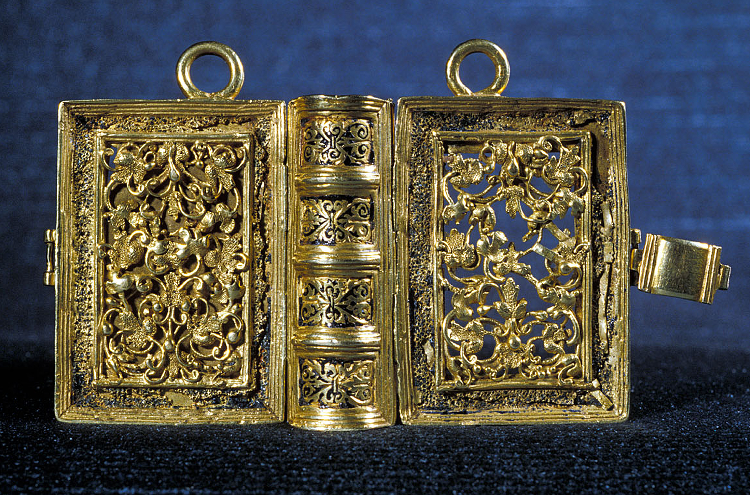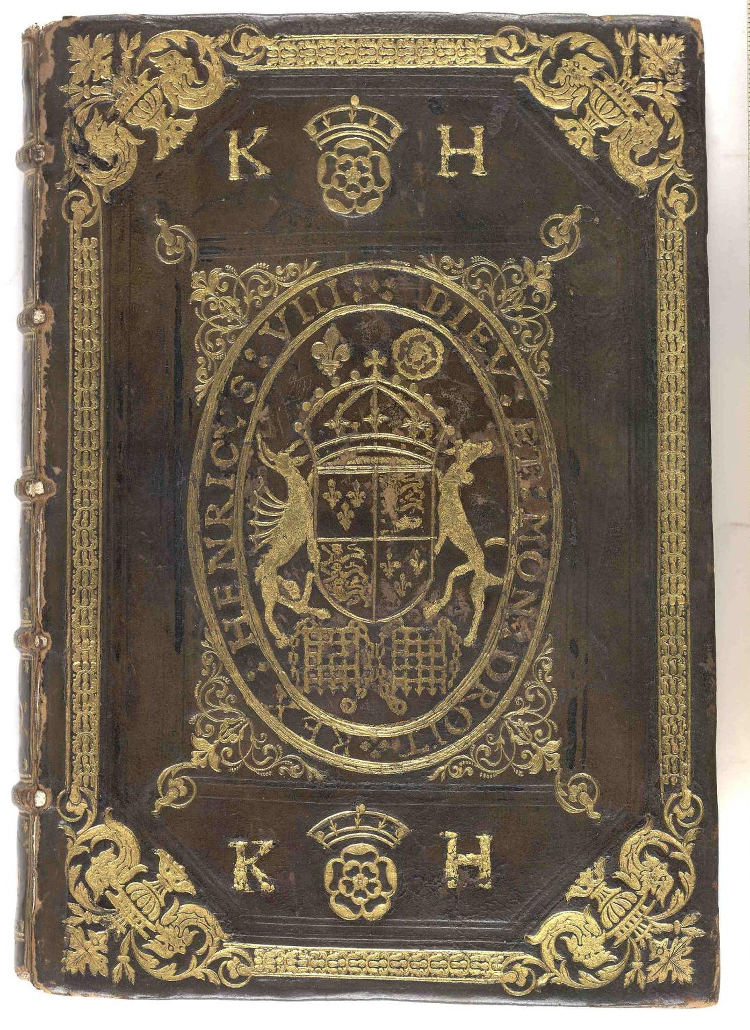There is some debate over whether Queen Catherine Howard was literate. However, we do have some examples of Catherine owning books which indicate that she was. It is very doubtful indeed, considering Catherine’s good lineage, that she would have received no education at all. Catherine was a member of the powerful Howard family, albeit a less important member, but she would have been expected to make a good marriage. Basic literacy and numeracy would be absolutely essential for household management.
Two of her predecessors were extremely intelligent and well-educated women, Queen Katherine of Aragon and Queen Anne Boleyn, and her successor Queen Katherine Parr even had two books published. It is easy to see how young Catherine may suffer in comparison.
James P. Carley notes that the majority of Catherine Howard’s books have been described as ‘litell’ or ‘very litell’ and must have been girdle books. A list of five books given to Catherine at the time of her marriage to Henry describes the elaborate bindings.
1. Item oone booke of golde ennamuled wherein is a clock. Upon every syde if which booke is thre diamondes, a litle man standing upon oone of them, foure turqueses and thre rubyes, with a little cheyne of gold hanging on it as ennamuled.
2. Item oone booke of gold ennamuled with blacke, garnesshed with xxvii rubyes, having also a cheyne of golde and perle to hange it by, conteignyng xliii peerlles.
3. Item oone other booke ennamuled with grene, white and blewe, havyng a feir sapher on euery side and viii rubyes upon the same booke.
4. Item oone other booke ennamuled with grene, white and red and garnesshed with viii small rubyes, having H.I. ennamuled with blacke, the backs of the same booke being glasse.
5. Item oone booke of golde conteignyng xii diamondes and xl rubyes.
These were certainly decorative items to be worn rather than read and were valued primarily for their bindings. The first ‘booke of golde’ is a clock case in the shape of a book. These were stored in coffers alongside jewels, bottles, mirrors and other domestic items. As we can see one of them had once belong to Queen Jane Semour, bearings the initials “H.I.” for Henry and Jane. None survive as the bindings were most likely broken up and re-used. However we have an example of a girdle book in the British Library collection, dated ‘pre-1600’.

This is bound in gold and black enamel, measuring a mere 40 x 30 millimetres. The two gold eyelets allowed the wearer to attach it to their belt by a gold chain. This British Library notes the legend of Anne Boleyn giving one of her maids of honour a prayer book on the scaffold, a lady of the Wyatt family, and have tentatively suggested this book was owned by Anne. However both Retha M. Warnicke and Eric Ives have disagreed with the legend, and James P. Carley doesn’t include this book in Anne’s collection. A description of the ‘Wyatt Prayer Book’ from 1873 notes it has an illumination depicting the trinity. The bindings are similar but Psalms in English verse contains a miniature of Henry VIII.

It is probable this girdle book was created during Henry VIII’s reign. The first owner it can be undoubtedly attributed to is the 1st duke of Buckingham and Chandos of Stowe House. He owned it during the 18th century, so the original owner remains a mystery. However it is certainly a good example of what Henry’s wives would have owned.
Catherine did not only own decorative books. The royal library travelled with the court on progress, therefore it was stored in coffers. An inventory of Catherine’s possessions were taken after her death, and four books are listed which which once belonged to her.
1. Item oone massee booke coverid with purple vellat with claspes of copper.
2. Item oone other litle masse booke coverid with lether.
3. Item oone Newe Testament coverid with purple vellat gernysshid with silver and gilt with two claspes to the same of like silver and gilt.
4. Item oone little French book coverid with crimson vellat having two claspes of gold with the scripture ‘Ihesus fiat uoluntas tua.’
These are, as Carley notes, not books for wearing, but books for consultation, and two are only described as ‘litle’ rather than ‘very litle’. The small collection indicates these books were for Catherine’s everyday use. She would have, of course, had access to her husband’s vast library. Catherine would have likely used these books at mass and for reading and being read to in her chambers. None of these books have survived either. The psalter books may have been destroyed during the reign of Edward VI, if they had not been broken up for their bindings earlier, although there is no indication if they are in Latin or English translations.
All of this indicates Catherine could certainly read, although this should hardly be a surprising conclusion. It is extremely doubtful Henry VIII, with his love of academic pursuits, would want an illiterate wife or allow his Queen Consort to be so ill-educated.
Of books dedicated to Catherine we have Richard Jonas’s The Byrth of Mankynde, Newly Translated Out of Laten Unto Englysshe. Jonas has dedicated it to our most gracious and virtuous Queen Katherine…for the love of all womanhood, and chiefly for the most bound service the which I owe unto your gracious highness.

This book is one of a group of fifteen with matching bindings. It has been identified, by James P. Carley by ‘process of elimination’, as being jointly owned by Henry and Catherine. Opus eximium, De uera differentia regiae potestatis et is a treatise defending royal power against the church – An Excellent Work on the True Difference Between Royal and Ecclesiastical Power. The initials represent Katherine and Henry, although the confusion that they stood for King Henry may be because Katherine’s initial is displayed first, which is slightly unusual. But Henry’s initials were of course H.R. The book was not printed until 1534, which means the initial does not represent Katherine of Aragon, and the book was listed in an inventory in Westminster in 1542, before Henry married Katherine Parr. Therefore this would indicate the binding was created when Henry was married to Catherine Howard (K for the contemporary spelling of her name).
Interestingly these were show books and in the library at Henry’s famous Nonsuch Palace. They were printed in Latin and were probably collected by Henry VIII over time and rebound during his marriage to Catherine. The collection contained a two volume set of Ambrose’s Omnia opera (1527); a six-volume set of Jerome’s Omnia opera (1524-6); a ten volume set of Augustine’s Omnia opera; a five volume edition of the Greek father St John Chrysostom (1523); and a single volume of works by Gregory the Great (1523). It is doubtful that young Catherine had received any education in humanism, one of Henry’s favourite topics, and probable she did not consult these volumes. It is a little sad that these are her only books that survived, and she did not have time to build up more of her own library.
Further Reading:
The Books of King Henry VIII and His Wives by James P. Carley
British Library Stowe 956
British Library c24a25
Anne Boleyn Files: The Wyatt Prayer Book
Anne Boleyn Files: Anne Boleyn and the Wyatt Prayer Book – The Prayers of Anne Boleyn?
Katherine Howard: A New History by Conor Byrne.



